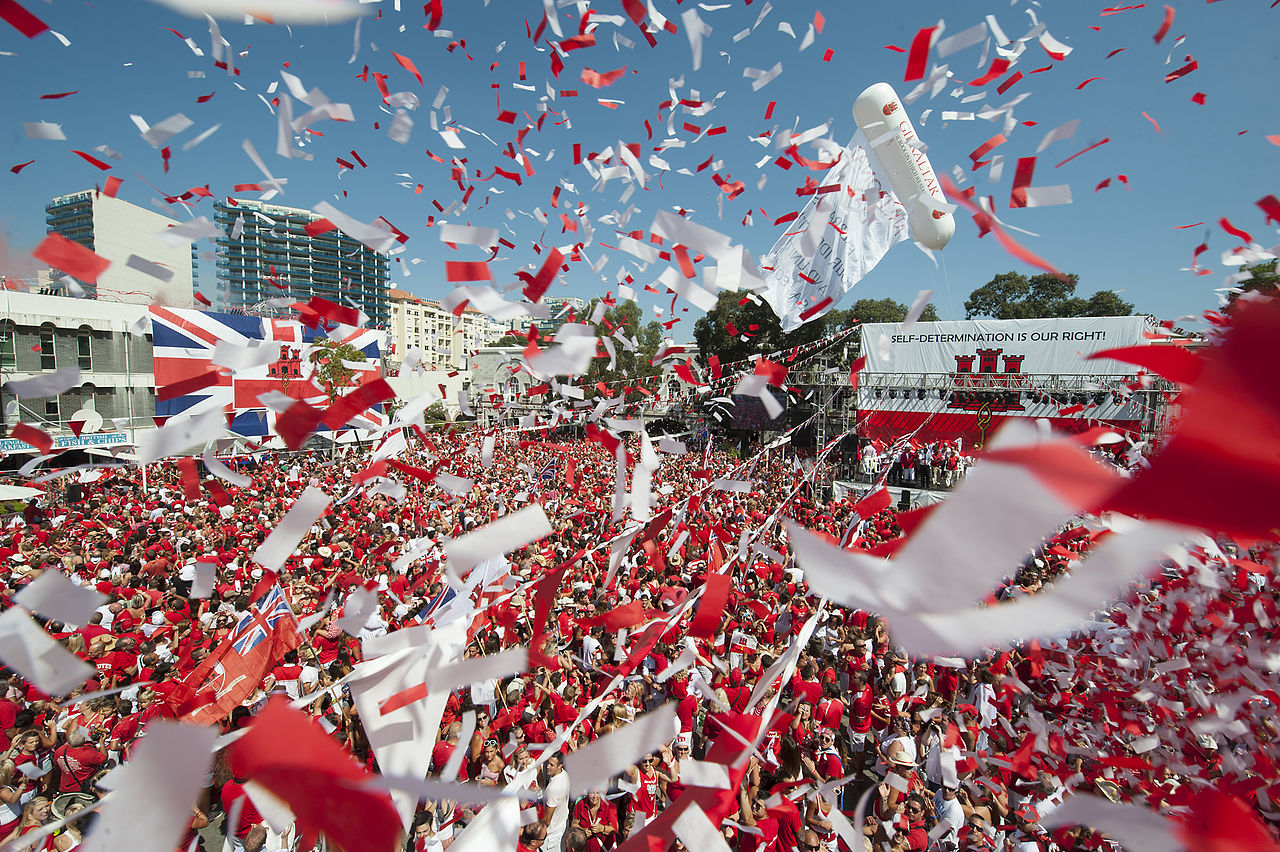THE hottest date on Gibraltar’s annual calendar is on 10 September, when it celebrates its historic National Day. This year, the Rock marks its 55th anniversary as a self-governing British territory, and thousands of revellers will flock to its public and private spaces to commemorate this grand occasion.
The festivities, returning in full force after the Covid pandemic, will be held in Casemates Square, John Mackintosh Square and Governor’s Parade. A tradition started in 1992, the celebration marks the identity and independence of Gibraltar and gives residents the chance to come together as one.

Plenty to celebrate
For Gibraltar, the date of 10 September signifies several historic moments. The most important is the 1967 sovereignty referendum, where residents were asked to vote whether they wanted to go under the sovereignty of Spain or remain with the UK, but with self-governed institutions. The result came out 100% in favour of remaining with Great Britain.
National Day is also a celebration of self-determination for Gibraltar, which has its own parliament of 17 elected members. Back in 1992, acting chief minister, Joe Bossano, visited the UN with the recently formed Self Determination for Gibraltar Group (SDGG). At the time, this new group was headed by Denis Matthews, a former member of the Integration with Britain Party. The pair soon ramped up support for their initiative.
As part of their campaign to gain the eyes, hearts and minds of the Gibraltarians, they held the first National Day at John Mackintosh Square (the Piazza) on 10 September 1992. At the time, the idea was to commemorate the 25th anniversary of the 1967 sovereignty referendum – they could not have seen the phenomenal growth and popularity of the event they had created!
Coincidentally, 10 September also marks the date when the Gibraltar Legislative Council became responsible for internal affairs in 1964, giving plenty to celebrate, all on one day.
Instant popularity of National Day
The inaugural run of National Day on 10 September 1992 was so successful that the attending crowd could not fit into the square!
After that first year, the Gibraltar government stepped in to help organise the event, provide some funding for the occasion, and declared 10 September a public holiday. In 1993, the venue was changed to the larger Grand Casemates Square and, in 1998, to the naval ground.
Today, the celebration runs at multiple sites and the residents don their national colours of red and white for fun family activities and a rousing public rally.
On top of that, the Rock’s private venues host their own special events in commemoration of National Day. Emilia Hazellsmith of Ocean Village, a thriving area of the Rock’s social scene, says: “National Day is an all-day event with music, dancing and great food and drinks – not to be missed, especially in Ocean Village. where live music and fun is the order of the day!”
Dress up, sign banner, come down
As is tradition, the official National Day celebrations start with a children’s fancy dress competition on Main Street, followed by a street party in John Mackintosh Square.
In the private sector, many of the Rock’s bars and restaurants have organised their very own celebrations, starting with breakfast parties and continuing all day long with various offers on food, drink and entertainment.
The day’s main attraction is the Freedom of the City ceremony, where the mayor reads the Gibraltar National Day Declaration to the gathered crowd.
The official entertainment also includes live music, aerial displays and family activities although, this year, there won’t be a fireworks display.
Ahead of the big day, the SDGG has been inviting residents to sign the National Day Banner, which is an expression of unity for inhabitants of the Rock. After being signed by thousands of people, via a stall in Casemates Square from 5-8 September, it will be displayed on the National Day stage on 10 September.
An audience with Richard Buttigieg of SDGG
Richard Buttigieg of Self Determination for Gibraltar Group (SDGG) talks to the Olive Press about Gibraltar’s big day and emphasises the important political aspect beyond the jovial celebration.
He says: “National Day is the most important function that the SDGG organises. It’s a day for families to have fun and join in the many events that take place but, first and foremost, it is a political rally to remind everyone that Gibraltar and the Gibraltarians have an undeniable and inalienable right to self-determination. That we should be the sole arbiters of our destiny and that no one should impose anything on us.”

“It is a day when we try to emphasise issues such as our unique national identity and, in my view, the importance of having a united front against those who may seek to undermine our right to self-determination.”
“The event started 30 years ago and has grown to become a week-long festivity with all sorts of cultural and social events taking place. From art and window shop dressing competitions to concerts and performances, and the political rally itself, we aim to provide something for everyone. We create different ways for the community to engage and experience a sense of pride and being part of the Gibraltarian community.”
“Something simple, such as getting as many Gibraltarians as possible to sign a banner which we display on the day, is a way of showing unity. Every year, we obtain several thousand signatures which, in a community the size of Gibraltar, shows the wide support the event attracts. And when you see Casemates Square and Main Street full of thousands of people, proudly wearing our red and white colours, it makes all the hard work worthwhile.”
The intriguing history of Gibraltar
A 6.8km2 limestone rock, Gibraltar is considered a special place by its 32,000 residents, who are known as Gibraltarians.
The Rock combines a close relationship with the UK with the best of the Mediterranean climate and lifestyle. It was an important naval base during both the Napoleonic Wars and WWII, as it controlled the narrow entrance and exit to the Mediterranean Sea, known as the Gibraltar Strait, which is just 14.3km wide. To this day, half of global seaborne trade passes through the Strait.
Going back in history, Gibraltar has been populated by many significant tribes and peoples. At Gorham’s Cave, there is evidence of Neanderthal habitation, with stone tools and animal bones. The island also shows evidence of Neolithic inhabitants, followed by Carthaginians and Romans, who called Gibraltar “Mons Calpe”, after one of the pillars of Hercules.
Following the collapse of the Roman Empire, Gibraltar was captured by the Vandals and became part of the Visigothic Kingdom of Hispania for 400 years.
During the Reconquista, in 711 A.D., the Moors conquered Gibraltar. The current name originates from Arabic – Jabal Tariq, which means “mount of Tariq”. When the Moors were expelled from Spain in 1462, it fell under Spanish rule.
During the War of the Spanish Succession in 1704, Anglo-Dutch armies conquered Gibraltar on behalf of a claim made to the Spanish crown by their ruling Habsburg family. In 1713, the Treaty of Utrecht handed the Rock to Great Britain – for keeps. Despite a couple of unsuccessful siege attempts by Spain, the Rock did not return to Spanish sovereignty, and the idea of Spanish rule was rejected by Gibraltarians in the referendum of 10 September 1967.
Over the centuries, Gibraltar has attracted inhabitants with Italian, Portuguese, Maltese, Jewish and French origin, as well as Brits.
In 2002, Gibraltar was designated as a British Overseas Territory, which it remains to this day.
It has, in August 2022, been recognised by the UK as a city.
The present economy of Gibraltar is largely based on tourism, online gambling, financial services and the supply of maritime fuel. It has its own airport and seaports. The inhabitants speak a mixture of Spanish, English and local dialect called Llanito.
READ MORE
What’s on at Gibraltar’s Ocean Village for National Day










